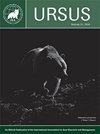在欧洲西南部,春季气温对带着幼崽的雌性棕熊的洞穴出口的影响
IF 0.6
4区 生物学
Q4 ZOOLOGY
引用次数: 3
摘要
摘要:冬眠代表了吸热动物克服食物匮乏不利时期的最精细的适应。因此,冬眠应该根据环境因素在特定的时间范围内进行。因此,生物事件发生时间的灵活性对哺乳动物如何应对变化的气候条件至关重要。对于棕熊(Ursus arctos)来说,冬眠不仅是一个关键时期,可以让它们在食物短缺的时候保存重要的能量储备,也是怀孕的母熊生下幼崽的时期。在此,我们分析了1995年至2018年西班牙西北部坎塔布连山脉记录的74只带幼崽的母熊出穴日期与(1)出穴前30天的平均日降水量和(2)平均最高气温以及(3)幼崽数量之间的关系。熊从4月1日至5月16日离开,平均日期为4月28日。我们的研究结果与其他研究报告的洞穴出现的总体纬度模式一致,表明在最高气温较高的年份,离开洞穴的日期往往更早,而幼崽的数量和离开洞穴前30天的平均降雨量似乎并不能决定洞穴离开日期的变化。考虑到春天的温度和带着幼崽的母熊离开洞穴的日期之间的关系,考虑到当前全球变暖可能对棕熊繁殖产生的影响是很重要的。目前的气候变化趋势可能会导致比过去更早的洞穴退出日期,这可能会对棕熊种群的种群动态产生负面影响。例如,冬眠时间和食物供应之间的不匹配可能会降低幼崽的存活率,从而降低雌性的健康。本文章由计算机程序翻译,如有差异,请以英文原文为准。
The role of spring temperatures in the den exit of female brown bears with cubs in southwestern Europe
Abstract: Hibernation represents the most refined adaptation of endothermic species to overcome unfavorable periods when food is scarce. Thus, hibernation should take place within specific time frames with respect to environmental factors. Flexibility in the timing of biological events is thus central to how well mammals can deal with varying climatic conditions. For brown bears (Ursus arctos), hibernation is not only a critical period that allows them to save vital energy reserves for times of food shortage, but also the period during which pregnant females give birth to cubs. Here, we analyzed the relationship between 74 den exit dates of females with cubs, recorded from 1995 to 2018 in the Cantabrian Mountains in northwestern Spain, with (1) average daily precipitation and (2) average maximum temperature during the 30 days before den exit, as well as with (3) the number of cubs. The bears exited from 1 April to 16 May, and the mean date was 28 April. Our results, which are consistent with the general latitudinal pattern of den emergence reported in other studies, suggested that in years with higher maximum temperatures, exit dates tended to be earlier, whereas the number of cubs and the average rainfall for the 30 days prior to den exit did not seem to determine the variation in den exit dates. Considering the relationship between spring temperatures and den exit dates of females with cubs, it is important to take into account the repercussions that current global warming may have on the reproduction of brown bears. Current trends of climate change might trigger earlier den exit dates than in the past, which may have negative consequences on the population dynamics of brown bear populations. For example, a mismatch between the chronology of hibernation and food availability might reduce cub survival and, consequently, the fitness of females.
求助全文
通过发布文献求助,成功后即可免费获取论文全文。
去求助
来源期刊

Ursus
生物-动物学
CiteScore
2.00
自引率
15.40%
发文量
12
审稿时长
>12 weeks
期刊介绍:
Ursus includes a variety of articles on all aspects of bear management and research worldwide. Original manuscripts are welcome. In addition to manuscripts reporting original research, submissions may be based on thoughtful review and synthesis of previously-reported information, innovative philosophies and opinions, and public policy or legal aspects of wildlife conservation. Notes of general interest are also welcome. Invited manuscripts will be clearly identified, but will still be subject to peer review. All manuscripts must be in English. All manuscripts are peer-reviewed, and subject to rigorous editorial standards.
 求助内容:
求助内容: 应助结果提醒方式:
应助结果提醒方式:


